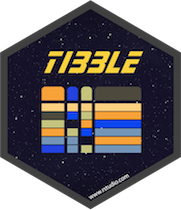# Copy this code into a chunk in R to make the Random_subset data frame from problem 1 and 2.
# Use the verbs we've discussed to make the subsets from the text.
Random_subset <- tibble::tribble(
~year,~sex, ~name, ~n, ~prop,
2003, "M", "Bilal", 146, 0.0000695,
1999, "F", "Terria", 23, 0.0000118,
2010, "F", "Naziyah", 45, 0.0000230,
1989, "F", "Shawana", 41, 0.0000206,
1989, "F", "Jessi", 210, 0.000105,
1928, "M", "Tillman", 43, 0.0000377,
1981, "F", "Leslee", 83, 0.0000464,
1981, "F", "Sherise", 27, 0.0000151,
1920, "F", "Marquerite", 26, 0.0000209,
1941, "M", "Lorraine", 24, 0.0000191
)The Verbs
Nic Schwab
dplyr lives in the tidyverse

SDS 100 Lab 4
You’ve learned about these verbs:
select()- subsets columns
filter()- subsets rows
mutate()- creates new variables (or columns)
arrange()/arrange(desc())
We will also use:
group_by()- to group the data before summarizing
summarize()- to summarize data
rename()- to rename columns
Recall SQL Queries
| SQL | dplyr |
|---|---|
| SELECT | select(), mutate(), summarise() |
| FROM | the data frame. data= |
| WHERE | filter() |
| ORDER BY | arrange() |
| LIMIT | slice_head() |
| GROUP BY | group_by |
The idea
You can get good at a few functions and do a lot.
The first argument is a data frame.
- its a special kind called a tibble.
The output of the wrangling functions is a data frame.
When we wrangle we are not altering the original data.
It still exists.
You can start over.
What is a tibble?

Object of class
tbl
Group by example
Live code with the mpg data frame.
Open R or Smith’s RStudio Server
Practice wrangling
In class MDSR Problems 1 and 2